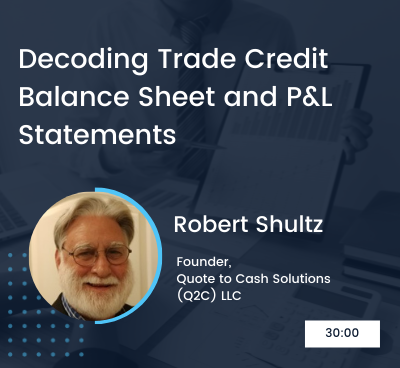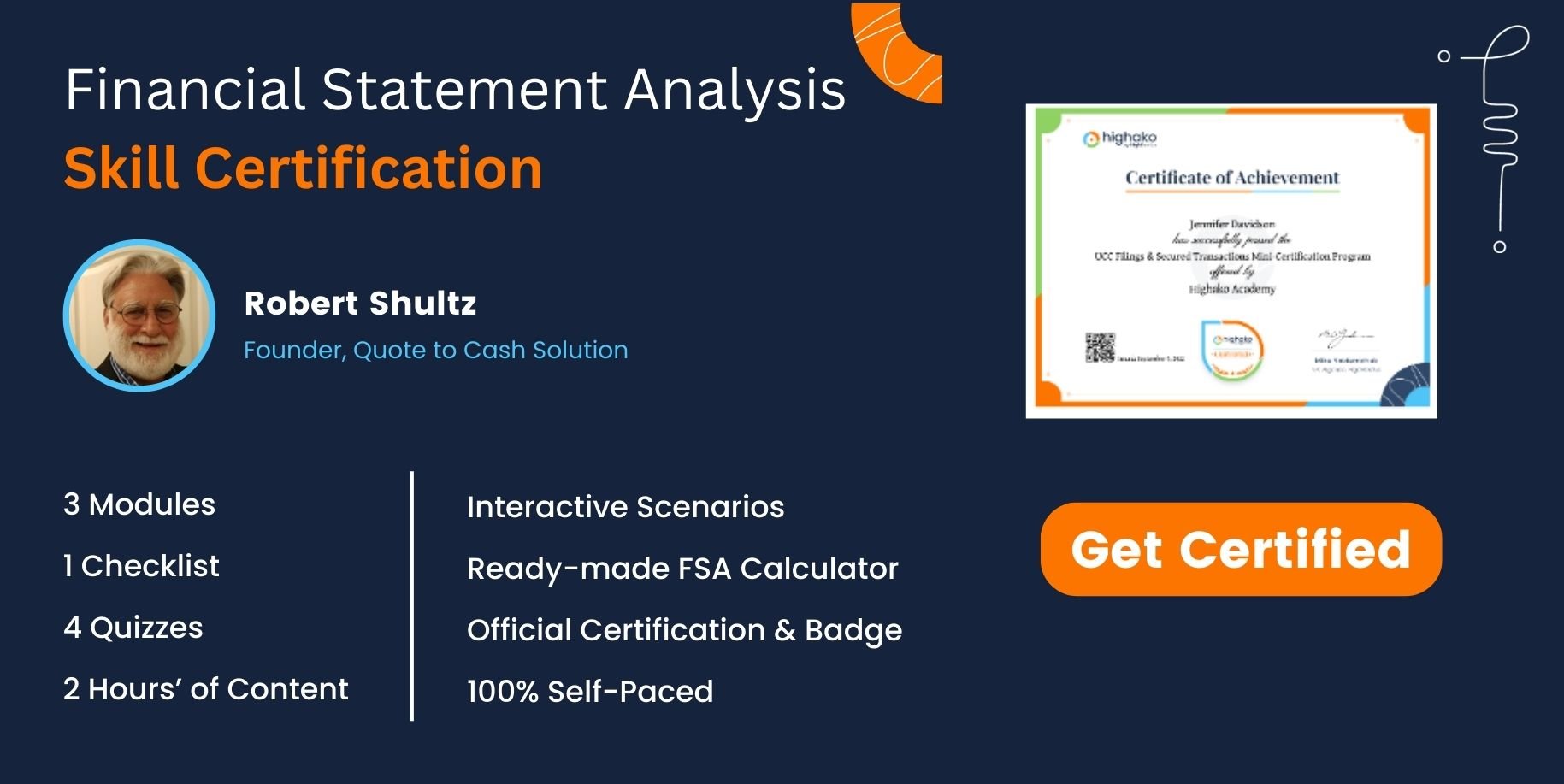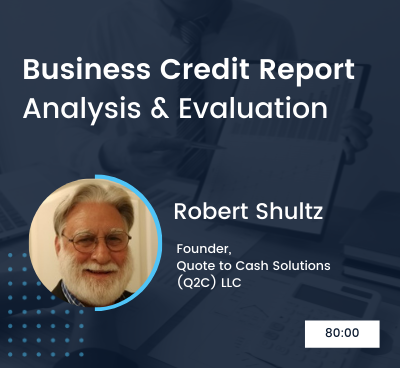There was an issue with saving this content. Please try again.
There was an issue with removing this item from your saved content. Please try again.
Decoding Trade Credit Balance Sheet and P&L Statements
About this Course
| promoImage |
 |
| description |
| lessonOverview |
“Rule No.1: Never lose money. Rule No.2: Never forget rule No.1.” – Warren Buffet
No company can ever be into business without interpreting customers’ balance sheets. What is a Balance Sheet?
Balance sheets are financial statements that provide an overview of what a company owns and owes. It also displays the amount invested by shareholders.
All credit analysts need to work on balance sheets to calculate financial ratios and profit and loss statements. But what purpose do the profit and loss statements serve, and why is it so important? The profit and loss statement summarizes the revenues, costs, and expenses incurred during a specified period.
The complete course on P&L, balance sheet, and cash flow statements would help you in understanding a company's financial performance.
This tutorial has been designed for a trade credit analyst and gives an overview of the components of a balance sheet. They also provide detailed knowledge of what assets, liabilities, and equity are in a balance sheet.
Watch this complete course to unlock the P&L formulas for decoding the measure of profitability while doing business.

|
| transcript |
Coming Soon
|
| resources |
Coming Soon |
|
| instructor |
| name |
title |
image |
description |
| ROBERT SHULTZ |
Founder, Quote to Cash Solution |
 |
Robert Shultz has had a thirty-year career as a global credit and financial executive for large multi-national companies. As a Founding Partner of Quote to Cash Solutions (Q2C) LLC, he provides consulting services in all aspects of the credit and collections process for companies of all sizes in a variety of industries. |
|
| recommendation |
| image |
tag |
title |
description |
link |
duration |
 |
Financial Statement Analysis |
Business Credit Report Analysis and Evaluation Tutorial |
Get an insight into Business Credit Reports to interpret Experian, Equifax, Ansonia trade reports for better credit scoring and risk analysis. |
https://academy.highako.com/trade-credit-report-analysis-course |
80 min |
 |
Credit Policy |
Credit Risk Assessment Training for Trade Creditors |
Learn how to assess Credit Risk and create Credit Scoring Models, and also, how to evaluate your customer creditworthiness. |
https://academy.highako.com/trade-credit-risk-assessment-course |
40 Min |
|
| tribe |
| widgetType |
Id |
components |
| topic |
financial-statement-analysis |
input |
|
Curriculum30 Mins
-
How to Read and Interpret A Balance Sheet (~ 20 mins)
-
An Overview of the Components of a Balance Sheet
-
What are Assets in a Balanced Sheet
-
What are Liabilities in a Balanced Sheet
-
What is Equity in a Balanced Sheet
-
Profit and Loss Analysis in Financial Statement (~ 10 mins)
-
A Brief Overview of the Profit and Loss Statement
-
The Importance of Profitability to a Company’s Financial Growth
-
How to Analyze a Company’s Profit and Cash Position
-
Quiz and Course Completion Certificate
-
-
About this Course
| promoImage |
 |
| description |
| lessonOverview |
“Rule No.1: Never lose money. Rule No.2: Never forget rule No.1.” – Warren Buffet
No company can ever be into business without interpreting customers’ balance sheets. What is a Balance Sheet?
Balance sheets are financial statements that provide an overview of what a company owns and owes. It also displays the amount invested by shareholders.
All credit analysts need to work on balance sheets to calculate financial ratios and profit and loss statements. But what purpose do the profit and loss statements serve, and why is it so important? The profit and loss statement summarizes the revenues, costs, and expenses incurred during a specified period.
The complete course on P&L, balance sheet, and cash flow statements would help you in understanding a company's financial performance.
This tutorial has been designed for a trade credit analyst and gives an overview of the components of a balance sheet. They also provide detailed knowledge of what assets, liabilities, and equity are in a balance sheet.
Watch this complete course to unlock the P&L formulas for decoding the measure of profitability while doing business.

|
| transcript |
Coming Soon
|
| resources |
Coming Soon |
|
| instructor |
| name |
title |
image |
description |
| ROBERT SHULTZ |
Founder, Quote to Cash Solution |
 |
Robert Shultz has had a thirty-year career as a global credit and financial executive for large multi-national companies. As a Founding Partner of Quote to Cash Solutions (Q2C) LLC, he provides consulting services in all aspects of the credit and collections process for companies of all sizes in a variety of industries. |
|
| recommendation |
| image |
tag |
title |
description |
link |
duration |
 |
Financial Statement Analysis |
Business Credit Report Analysis and Evaluation Tutorial |
Get an insight into Business Credit Reports to interpret Experian, Equifax, Ansonia trade reports for better credit scoring and risk analysis. |
https://academy.highako.com/trade-credit-report-analysis-course |
80 min |
 |
Credit Policy |
Credit Risk Assessment Training for Trade Creditors |
Learn how to assess Credit Risk and create Credit Scoring Models, and also, how to evaluate your customer creditworthiness. |
https://academy.highako.com/trade-credit-risk-assessment-course |
40 Min |
|
| tribe |
| widgetType |
Id |
components |
| topic |
financial-statement-analysis |
input |
|
Curriculum30 Mins
-
How to Read and Interpret A Balance Sheet (~ 20 mins)
-
An Overview of the Components of a Balance Sheet
-
What are Assets in a Balanced Sheet
-
What are Liabilities in a Balanced Sheet
-
What is Equity in a Balanced Sheet
-
Profit and Loss Analysis in Financial Statement (~ 10 mins)
-
A Brief Overview of the Profit and Loss Statement
-
The Importance of Profitability to a Company’s Financial Growth
-
How to Analyze a Company’s Profit and Cash Position
-
Quiz and Course Completion Certificate
-
-





